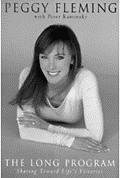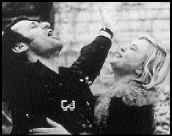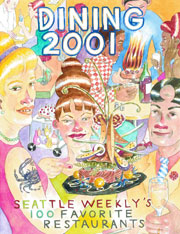WHEN YOU THINK of figure skater Peggy Fleming, it’s hard not to think of her voice first. As the one who soothes ABC Sports’ Dick Button when he reacts violently to a skater’s performance, she subtly turns our attention from the competitor’s weaknesses to his or her strengths. When the camera settles on these unlikely co-commentators, Fleming’s smile is ready and flashing, her regal though modest bearing hardly giving away that she won an Olympic gold medal in 1968. By contrast, when you think of 1984 Olympic gold medalist Scott Hamilton, you can’t as easily picture him rinkside with a mike in his hand: He’s the consummate showman who executes back flips and impossibly nimble footwork.
The Long Program: Skating Toward Life’s Victories by Peggy Fleming with Peter Kaminsky Pocket Books, $24.95
Landing It: My Life On and Off the Ice by Scott Hamilton with Lorenzo Benet Kensington Books, $25.95
Still reaping the professional and financial rewards of skating’s unswerving popularity, both Fleming and Hamilton now add memoirs to their many achievements. What makes this fairly interesting is an odd coincidence: Not only are both former Olympic champions; they also have both survived cancer.
Unfortunately, Fleming’s story unfolds as a series of saccharine personal philosophies based on her book’s title. The Long Program, as she understands it, isn’t just that four-minute chance to win or lose in front of the judges; it’s Life and how you get through it. “I believe we all have a Long Program,” she writes. “Whether life’s ice is chewed up or like glass, whether the crowd is kind or hostile, whether you feel sick or fit, it is only by living each moment that we learn how things will turn out.”
Fleming recalls her blue-collar upbringing and how her skating offered an escape from the family’s constant financial worries. Shy but talented, she moved from coach to coach at the urging of her domineering mother. When she finally settled into a routine with the legendary Carlo Fassi, she emerged to dazzle the crowds in Grenoble with her chartreuse dress and swanlike carriage. Ice shows, a solid marriage, two sons, a bout with breast cancer, and a grandson later, Fleming reflects on her charmed life with an astonishing lack of depth. She’s clearly more comfortable—and so are we seeing her—at Button’s side. Through all of her strained positive messages (on parenting, marriage, family, athletics, health, etc.), Fleming is memorable only for her banal, unintentionally funny reflections. A few examples:
On chiffon: “Because it is softer, you have to keep moving to make it behave more flatteringly. . . . It did everything I wanted it to do.”
On going to a spa: “We went to seminars. We read. We made wreaths out of wild herbs. We played bingo. We had massages and loofa scrubs.”
On body image: “When the waistband gets a little tight and my size 8 body has trouble getting into my size 4 or 6 dress, I know one of two things is probably true: I haven’t been exercising, or I’ve been eating too much. . . . “
HAMILTON’S TELL-ALL, on the other hand, is one of the more entertaining world-of-skating books you’re likely to come across. It’s exactly what you’d expect from this scrappy guy, who almost didn’t make it past age 9 due to a malabsorption illness. From his sickly childhood to a career checkered with hard partying, deaths of those close to him, and girl trouble, Hamilton continues to bask in the unprecedented opportunities he’s been offered as a male skater in his early 40s. He inspires us because he makes up for his lack of height, weight, and health through sheer willpower. He rockets through his career with an upbeat appreciation of the changes in the sport and a determination to continue to improve physically and mentally as a performer, even after being diagnosed with testicular cancer in 1997. Hamilton comes back to the ice after treatments end. In learning how to jump again, he faces the decline of a long skating career. “Yes, I know someday it will end,” he writes. “Perhaps now I’m better equipped to deal with that reality.”
Hamilton’s longtime presence in skating’s pantheon provides the perfect vantage point for dishing on the sport’s ever-shifting heroes. As the founding performer of “Stars on Ice” (formerly “Scott Hamilton’s America Tour”), he’s been there, done that, dated her, gotten drunk with him, seen so-and-so throw a fit backstage. Not only that, he grounds the reader in his intensive amateur experiences early on in the book. We follow him to and from grueling practice sessions, and actually feel the circuitous monotony of his training as it builds toward bigger competitions. From struggling to land a double flip-triple toe loop in combination to listening to the J. Geils Band while practicing figures, Hamilton fills us in on his obsessions, particular to this strange universe where two thin blades get you where you want to go.








